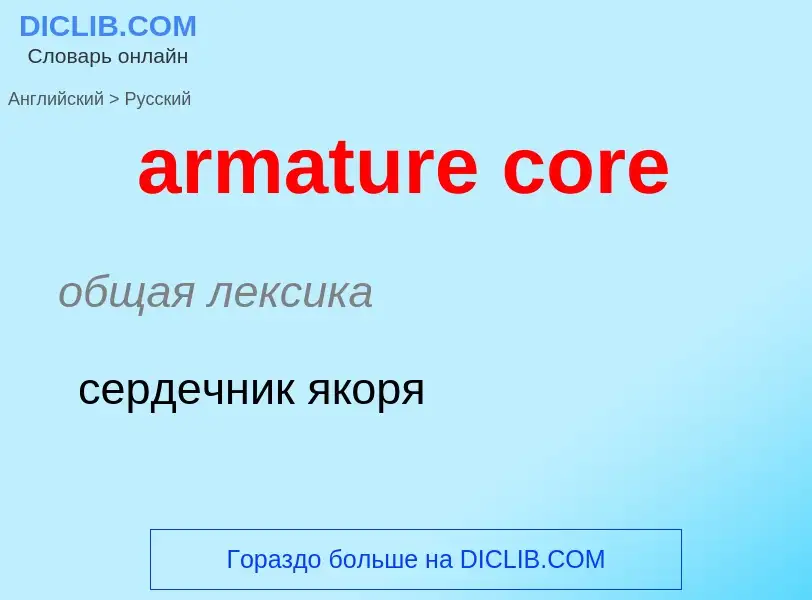Перевод и анализ слов искусственным интеллектом ChatGPT
На этой странице Вы можете получить подробный анализ слова или словосочетания, произведенный с помощью лучшей на сегодняшний день технологии искусственного интеллекта:
- как употребляется слово
- частота употребления
- используется оно чаще в устной или письменной речи
- варианты перевода слова
- примеры употребления (несколько фраз с переводом)
- этимология
armature core - перевод на русский
общая лексика
сердечник якоря
['kɔ:'mem(ə)ri]
общая лексика
ЗУ на магнитных сердечниках
тип ОЗУ, использовавшийся в ЭВМ второго поколения (конец 50-х, начало 60-х годов), вытеснен полупроводниковой памятью. Магнитный сердечник можно намагничивать в одном из двух направлений. Затем направление магнитного поля можно определять по его воздействию на электрический ток, проходящий через центр сердечника
вычислительная техника
запоминающее устройство ЭВМ на (магнитных) сердечниках
Смотрите также
общая лексика
насквозь
общая лексика
(грунтовая) ударная трубка
строительное дело
самопогружающийся (гравитационный) грунтонос (для отбора грунта с морского дна)
нефтегазовая промышленность
гравитационный пробоотборник
общая лексика
буровая проба
добыча полезных ископаемых
керн
колонка породы
строительное дело
образец, вырезанный из толщи бетона, грунта
нефтегазовая промышленность
образец керна (цельного или расколотого)
общая лексика
петлевая обмотка
строительное дело
вращательное бурение с обратной промывкой
Определение
Википедия

In sculpture, an armature is a framework around which the sculpture is built, when the sculpture could not stand on its own. This framework provides structure and stability, especially when a plastic material such as wax, newspaper or clay is being used as the medium. When sculpting the human figure, the armature is analogous to the major skeleton and has essentially the same purpose: to hold the body erect.
An armature is often made of heavy, dark aluminium wire which is stiff, but can be bent and twisted into shape without much difficulty. The wire is affixed to a base which is usually made of wood. The artist then begins fleshing out the sculpture by adding wax or clay over the wire. Depending on the material and technique, the armature may be left buried within the sculpture but, if the sculpture is to be hollowed out for firing, it must1 be removed.
Large representational sculptures meant for outdoor display are typically fashioned of bronze or other types of sheet metal, and they require armatures for internal support and stability. For example, a large armature designed by Gustave Eiffel holds up the Statue of Liberty. The armature can be seen from below by visitors to the base of the sculpture's interior.



![A 10.8×10.8 cm plane of magnetic core memory with 64 x 64 bits (4 Kb), as used in a [[CDC 6600]]. Inset shows ''word line'' architecture with two wires per bit A 10.8×10.8 cm plane of magnetic core memory with 64 x 64 bits (4 Kb), as used in a [[CDC 6600]]. Inset shows ''word line'' architecture with two wires per bit](https://commons.wikimedia.org/wiki/Special:FilePath/Ferrite core memory.jpg?width=200)




![This [[microSDHC]] card holds 8 billion bytes (8 GB). It rests on a section of magnetic-core memory that uses 64 cores to hold eight bytes. The microSDHC card holds over one billion times more bytes in much less physical space. This [[microSDHC]] card holds 8 billion bytes (8 GB). It rests on a section of magnetic-core memory that uses 64 cores to hold eight bytes. The microSDHC card holds over one billion times more bytes in much less physical space.](https://commons.wikimedia.org/wiki/Special:FilePath/8 bytes vs. 8Gbytes.jpg?width=200)
![US quarter]] for scale US quarter]] for scale](https://commons.wikimedia.org/wiki/Special:FilePath/Magnetic-core memory, 18x24 bits.jpg?width=200)


![Bakken]] Core samples Bakken]] Core samples](https://commons.wikimedia.org/wiki/Special:FilePath/Cut Bakken Core samples.jpg?width=200)


